Calipari dribble-drive
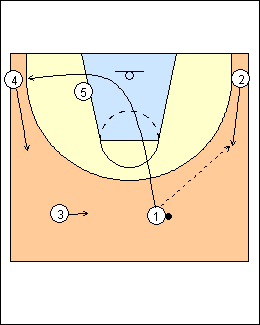 | 1 John Calipari See Offence - Walberg dribble-drive attack. The point guard is inside the right elbow, he can drive it either way (if he gets outside he will be forced one way). The point guard looks to score a layup every time, they're in the offence on a pass to 3 or 2. 2 is one of the best scorers and creators, bury him below the rim, ready to shoot, but they are counting on the defence not leaving him to help. 5 rim runs then moves away, the ballside is open. 3 is the secondary ballhandler, he is at the midpoint between the left elbow and the sideline. 4 is a secondary scorer and the other big man. 2-3-4 are all the same, if 4 is a better handler than 3, flip them. The court is wide open, they are trying to create lanes to the basket, the spacing creates lanes for the point guard. They don't mind if a player shoots a long 3, if it almost goes in it will stretch the defence. Any player can try to beat their man left or right (make one move), but not every player can do it, some are passers and cutters, some are shooters who look to drive if they are crowded. Any cut is a hard cut, a cutter is creating for his teammates, he can't jog through. It's a tilted court, one guy is isolated. |
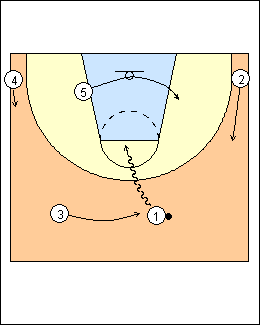 | On a middle drive by 1, 3 comes behind (if he slides away his defender can play both), 5 gets to the other side of the rim, his footwork is right (crossover), left, hop reverse pivot. The corners play opposite each other, ballside 4 comes one step out of the corner (they are trying to keep his defender buried in the corner). Weakside 2 comes up automatically. A pass from 1 to 3 is a pitch. A negative pitch means that 3 wasn't running downhill, he's in front of 1, it becomes a weave, which doesn't work. A positive pitch is behind or beyond 1, 3 is trying to get a layup. The whole offence is predicated on running downhill on any catch. If your man is not tight, hesitate and read what the defence is trying to do, then drive. If the defender will sag and go under, look to catch it tighter to the basket and shoot. If 1 is stopped he passes in the direction of the help - where the help came from. If he spins back right, he has to shoot. |
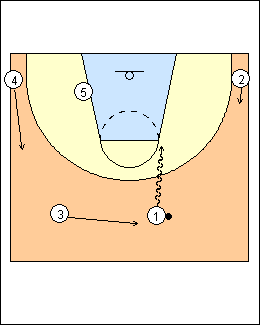 | If 1 drives right, 3 fills behind, 4 lifts weakside as soon as 1 starts to go, his man is going to help in, 5 looks to seal him in for a pass to 4, if X4 doesn't help in, look for a lob pass to 5. |
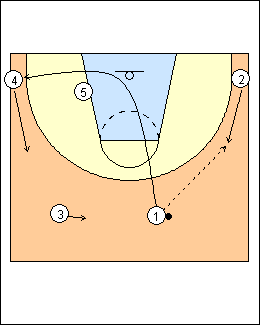 | On a pass to the wing, they want him to drive. 1 basket cuts and clears away. Jerry Petitgoue - they don't drive baseline very often (teams load up on that), but on "through", 1 passes to 2 and goes through, they want a baseline drive by 2. |
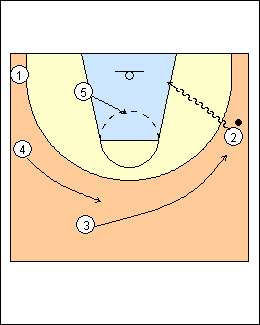 | 5 If 2 drives baseline it's conventional basketball, 5 goes to the broken line, 3 fills behind, there's a skip pass to 4 over the top. |
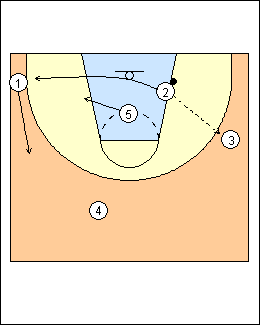 | 6 If 2 gets stuck he knows he has a guy behind him. On a pass to 3, 2 opens and goes away to create a lane for 3, 5 gets back out. |
 | 7 On a middle drive inside the elbow, 4 and 1 fill behind outside the NBA 3, if 3 and 1 cross, it's when the ball gets to the middle of the lane, and that's when 2 comes out of the corner straight to the "X" position (foul-line extended, replacing 1). |
 | They have calls that will get 2 up to his X, one is on a middle drive from the other side, he doesn't move until the ball gets to the middle of the lane. On ballside, on a call 1 can stop at the elbow, 2 lifts for a pass, then 1 cuts to the corner. 2's job is to get to the X, catch it and run downhill. If 2 drives baseline, 5 goes to the broken line. Walberg - if 1 drives to the elbow (stops in the drop zone), he is looking for 2 to go backdoor, if X2 opens up to defend the backdoor, 2 kicks up for a pass. |
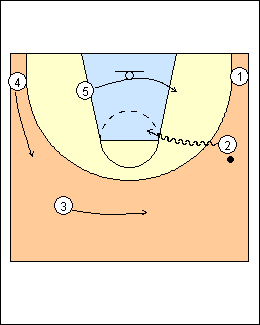 | 9 If 2 drives middle. |
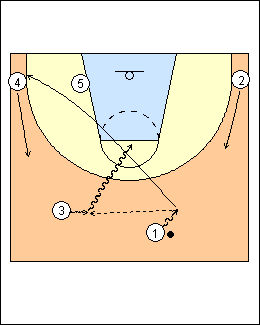 | To create a lane for 3, 1 will pass to him and cut, 3 drives off his butt. To create a big gap, 1 cuts all the way to the corner, 2 comes out when 3 gets to the middle. 1 will drag the dribble a little to the right and 3 comes to catch it a little tighter for more space. |
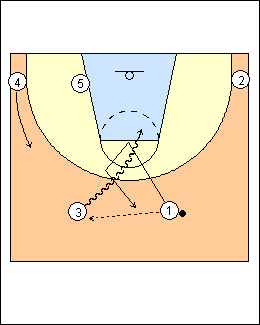 | More often 1 will cut hard to the nail (nail cut), it allows 3 to drive right or left. 1 will v-cut and fill behind if 3 drives right, 4 comes up to his X. If X1 is going to stop at the foul line on the nail cut, 1 basket cuts, 2 comes up, look for a lob pass. They are trying to get the other team to defend in ways they have never done, instead of help and recover you either stop the ball or go with your man. |
 | 12 Here 3 drives left. |
 | Creating a lane for 4. (Note that if 5 is usually weakside when the ball is on a wing, to post him up you need triggers, see below) |
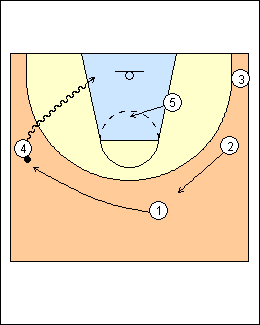 | 14 A baseline drive is conventional. |
 | 15 Using 5 Running upcourt into the offence - if X5 is trailing 5 may stop and seal for a pass over the top from 1 - if X5 is under the basket and 5 knows he's better, he will plant and pivot for a direct pass - if X5 is beside 5, 1 will pass to the wing on the other side, if 5 doesn't get a pass he lets the wing know "I'm gone, I'm gone", they're already in the offence. They have ways to get 5 involved if they want him to drive. One is that 1 pushes 2 through then passes to 5 coming to the ballside elbow. |
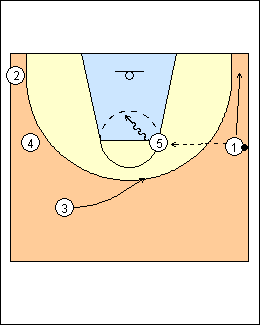 | 16 1 can backcut or go to the ballside corner. They look for 3's man to help, 5 drives middle and 3 fills behind for a layup. |
 | 17 If 5 can really shoot they don't want him to always relocate. 1 drives middle, 3 fills behind, 4 gets out, 2 is up a little bit, they push 5 right back, 1 passes to 5 and goes through and out. |
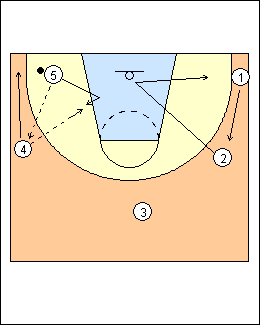 | 18 5 can shoot or attack on an open court, if he wants he can pass to 4 and post. There are two ballside options, if 4 passes to 5 on the block, 4 goes dead corner, even with the backboard, opening up the court. 2 can make a hard cut to the rim then go out weakside if he doesn't get it, 5 plays. Mads Olesen - on any pass into the post look to have the opposite high dive and opposite diagonal elevate. The passer may stay, relocate to the corner, get a screen from the ballside top (if a shooter), or set a screen for a shooter on the ballside top. |
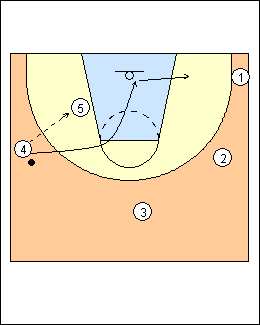 | 19 If 5 is out a bit from the block, 4 passes and goes through the elbow to the rim then out, even if 2 cuts. |
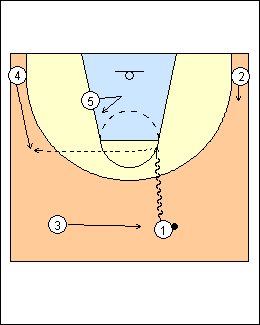 | Post-ups 1) 1 drives to the elbow, skips it over the top to 4, 5 posts. 1 looks at X4, if he's sagging, throw it to 4, 5 buries his man inside. X5 is helping on the drive if 1 is going hard. Walberg - if X5 helps on 1 and X4 helps on 5, 1 skips to 4, 5 posts - if you want to get 5 the ball, 1 passes to 3 and holds (does not cut), 4 pops up for a pass and gets it inside. |
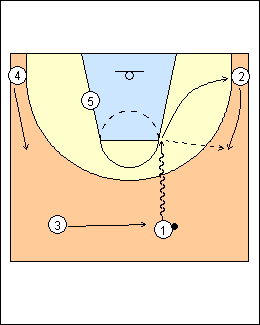 | 2) Kickback - throwing the ball back to the guy who started it is an automatic post-up. For example, 1 drives the elbow, passes to 2 at the X, and cuts to the corner. |
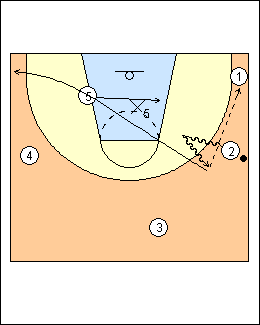 | 22 2 drives middle, makes a pullback dribble, throws it back to 1 (kickback), 5 comes under X5, who is playing a one-man zone. 2 cuts through, giving 1 room to drive middle. |
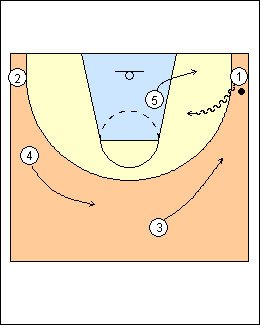 | 23 If 1 drives middle, 5 steps out, 2 will not come out of the corner until 1 gets to the middle. |
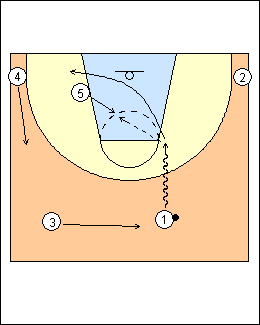 | 3) Duck him in When you have the ball it's your game, you're trying to score, your job is to beat your man. If all that doesn't work, if you look at the post, he's coming to catch it every time. Here 1 passes to 5 ducking in, then basket cuts (always). If X5 knows that 5 will duck in, 5 will take one step up the lane with his inside foot and spin back the other way (on his outside foot) for a lob. Or 5 may go straight up the lane, catch and square up. |
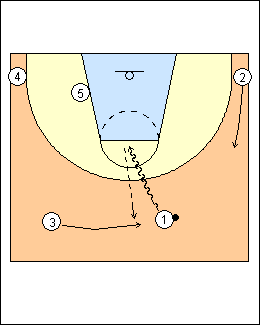 | Second drives 1) The first drive is a pitch from 1 to 3. |
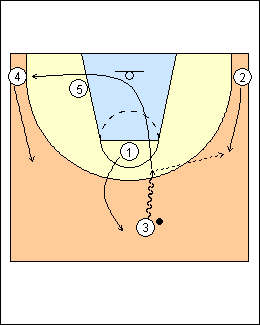 | 26 3 drives (second drive), hits 2 and goes through, 2 attacks the basket (third drive). See Matt Bollant Quick. |
 | 2) 1 hits 2 and cuts through. |
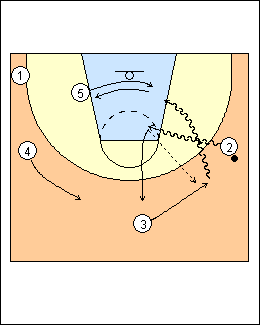 | 28 2 drives middle, hits 3 filling behind for a layup. |
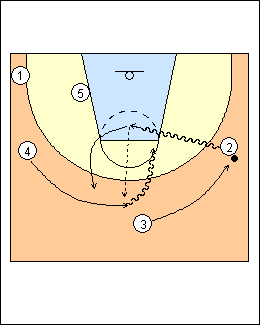 | 29 Or 2 hits 4 when he gets into the middle. As a high-school team you're going to get so many layups that it's hard to get to the second layups. The offence is not hard but to teach it you have to do the drills, the running drills, the individual instruction, because you have to train your players in a different way, it's not conventional basketball. You're teaching players how to play, not how to make plays. Players love it, it makes practices fun. Everything is scored, losers run. |
This page was made with Basketball playbook from Jes-Soft